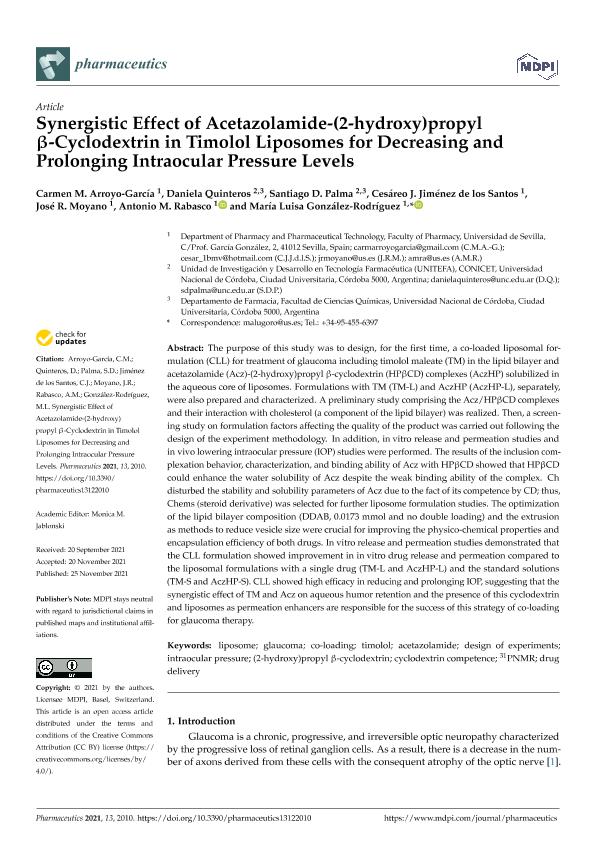Mostrar el registro sencillo del ítem
dc.contributor.author
Arroyo García, Carmen M.
dc.contributor.author
Quinteros, Daniela Alejandra

dc.contributor.author
Palma, Santiago Daniel

dc.contributor.author
Jiménez de los Santos, Cesáreo J.
dc.contributor.author
Moyano, José R.
dc.contributor.author
Rabasco, Antonio M.
dc.contributor.author
González Rodríguez, María Luisa
dc.date.available
2023-01-05T20:18:37Z
dc.date.issued
2021-11-25
dc.identifier.citation
Arroyo García, Carmen M.; Quinteros, Daniela Alejandra; Palma, Santiago Daniel; Jiménez de los Santos, Cesáreo J.; Moyano, José R.; et al.; Synergistic effect of acetazolamide-(2-hydroxy)propyl β-cyclodextrin in timolol liposomes for decreasing and prolonging intraocular pressure levels; MDPI; Pharmaceutics; 13; 12; 25-11-2021; 1-28
dc.identifier.uri
http://hdl.handle.net/11336/183619
dc.description.abstract
The purpose of this study was to design, for the first time, a co-loaded liposomal formulation (CLL) for treatment of glaucoma including timolol maleate (TM) in the lipid bilayer and acetazolamide (Acz)-(2-hydroxy)propyl β-cyclodextrin (HPβCD) complexes (AczHP) solubilized in the aqueous core of liposomes. Formulations with TM (TM-L) and AczHP (AczHP-L), separately, were also prepared and characterized. A preliminary study comprising the Acz/HPβCD complexes and their interaction with cholesterol (a component of the lipid bilayer) was realized. Then, a screening study on formulation factors affecting the quality of the product was carried out following the design of the experiment methodology. In addition, in vitro release and permeation studies and in vivo lowering intraocular pressure (IOP) studies were performed. The results of the inclusion com-plexation behavior, characterization, and binding ability of Acz with HPβCD showed that HPβCD could enhance the water solubility of Acz despite the weak binding ability of the complex. Ch disturbed the stability and solubility parameters of Acz due to the fact of its competence by CD; thus, Chems (steroid derivative) was selected for further liposome formulation studies. The optimization of the lipid bilayer composition (DDAB, 0.0173 mmol and no double loading) and the extrusion as methods to reduce vesicle size were crucial for improving the physico-chemical properties and encapsulation efficiency of both drugs. In vitro release and permeation studies demonstrated that the CLL formulation showed improvement in in vitro drug release and permeation compared to the liposomal formulations with a single drug (TM-L and AczHP-L) and the standard solutions (TM-S and AczHP-S). CLL showed high efficacy in reducing and prolonging IOP, suggesting that the synergistic effect of TM and Acz on aqueous humor retention and the presence of this cyclodextrin and liposomes as permeation enhancers are responsible for the success of this strategy of co-loading for glaucoma therapy.
dc.format
application/pdf
dc.language.iso
eng
dc.publisher
MDPI
dc.rights
info:eu-repo/semantics/openAccess
dc.rights.uri
https://creativecommons.org/licenses/by-nc-sa/2.5/ar/
dc.subject
31PNMR
dc.subject
(2-HYDROXY)PROPYL Β-CYCLODEXTRIN
dc.subject
ACETAZOLAMIDE
dc.subject
CO-LOADING
dc.subject
CYCLODEXTRIN COMPETENCE
dc.subject
DESIGN OF EXPERIMENTS
dc.subject
DRUG DELIVERY
dc.subject
GLAUCOMA
dc.subject
INTRAOCULAR PRESSURE
dc.subject
LIPOSOME
dc.subject
TIMOLOL
dc.subject.classification
Oftalmología

dc.subject.classification
Medicina Clínica

dc.subject.classification
CIENCIAS MÉDICAS Y DE LA SALUD

dc.title
Synergistic effect of acetazolamide-(2-hydroxy)propyl β-cyclodextrin in timolol liposomes for decreasing and prolonging intraocular pressure levels
dc.type
info:eu-repo/semantics/article
dc.type
info:ar-repo/semantics/artículo
dc.type
info:eu-repo/semantics/publishedVersion
dc.date.updated
2022-09-07T14:10:55Z
dc.identifier.eissn
1999-4923
dc.journal.volume
13
dc.journal.number
12
dc.journal.pagination
1-28
dc.journal.pais
Suiza

dc.journal.ciudad
Basel
dc.description.fil
Fil: Arroyo García, Carmen M.. Universidad de Sevilla; España
dc.description.fil
Fil: Quinteros, Daniela Alejandra. Consejo Nacional de Investigaciones Científicas y Técnicas. Centro Científico Tecnológico Conicet - Córdoba. Unidad de Investigación y Desarrollo en Tecnología Farmacéutica. Universidad Nacional de Córdoba. Facultad de Ciencias Químicas. Unidad de Investigación y Desarrollo en Tecnología Farmacéutica; Argentina. Universidad Nacional de Córdoba. Facultad de Ciencias Químicas. Departamento de Farmacia; Argentina
dc.description.fil
Fil: Palma, Santiago Daniel. Consejo Nacional de Investigaciones Científicas y Técnicas. Centro Científico Tecnológico Conicet - Córdoba. Unidad de Investigación y Desarrollo en Tecnología Farmacéutica. Universidad Nacional de Córdoba. Facultad de Ciencias Químicas. Unidad de Investigación y Desarrollo en Tecnología Farmacéutica; Argentina. Universidad Nacional de Córdoba. Facultad de Ciencias Químicas. Departamento de Farmacia; Argentina
dc.description.fil
Fil: Jiménez de los Santos, Cesáreo J.. Universidad de Sevilla. Facultad de Farmacia.; España
dc.description.fil
Fil: Moyano, José R.. Universidad de Sevilla. Facultad de Farmacia.; España
dc.description.fil
Fil: Rabasco, Antonio M.. Universidad de Sevilla. Facultad de Farmacia.; España
dc.description.fil
Fil: González Rodríguez, María Luisa. Universidad de Sevilla. Facultad de Farmacia.; España
dc.journal.title
Pharmaceutics
dc.relation.alternativeid
info:eu-repo/semantics/altIdentifier/url/https://www.mdpi.com/1999-4923/13/12/2010
dc.relation.alternativeid
info:eu-repo/semantics/altIdentifier/doi/http://dx.doi.org/10.3390/pharmaceutics13122010
Archivos asociados
